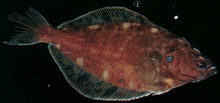
American Plaice belongs to the flatfish group of fishes whose members are strongly compressed laterally and tend to lie and swim on one side. When the young fish hatch from an egg they have the normal fish form. During development, as they settle to the bottom of the ocean, a profound change occurs in body structure. the head becomes twisted so that the fish now swims and lies on it's side. Plaice almost always have their eyes on the right side of the body. The body is covered with relatively small scales and the tail fin is rounded. Plaice have a large mouth that extends at least below the middle of the eye. Plaice are normally reddish to greyish brown on the dorsal, upper pigmented side of their body and are pale white on the ventral, lower side of their body. Larval plaice feed on minute plankton in the surface layers. Adult plaice feed on sand dollars, brittle stars, shrimp-like amphipods and polychaete worms as well as small fish ( predominantly capelin and sand lance ) Female plaice begin to spawn at 8 or 9 years of age when they are 30 cm in length. Most female plaice do not reach the spawning stage until they are 11 years of age and 45 cm in length. Some male plaice become sexually mature when they are 3 years of age and 20 cm in length. All male plaice are sexually mature by the age of 6 when they are 30 cm in length. On average a female plaice produces 250,000 to 300,000 eggs and a 70 cm female plaice can produce 1,500,000 eggs. Spawning and fertilization of the eggs occurs at or near the bottom and the fertilized, buoyant eggs float to the surface layer where hatching occurs. Certain locales offer environmental conditions such as bottom type, temperature and depth which are particularly favorable for spawning activity.
About 73,000 tons of plaice were landed off eastern Canada in 1980, primarily off the Grand Banks of Newfoundland. About 4,000 metric tons are landed by the inshore gill net fishery each year off the east coast of Newfoundland as well. Plaice accounts for two-thirds of total Newfoundland trawler landings and for about 50 percent of the flatfish landed by the Canadian fishery. The six major Atlantic Plaice stocks are in much better shape than the northern Cod stocks.
